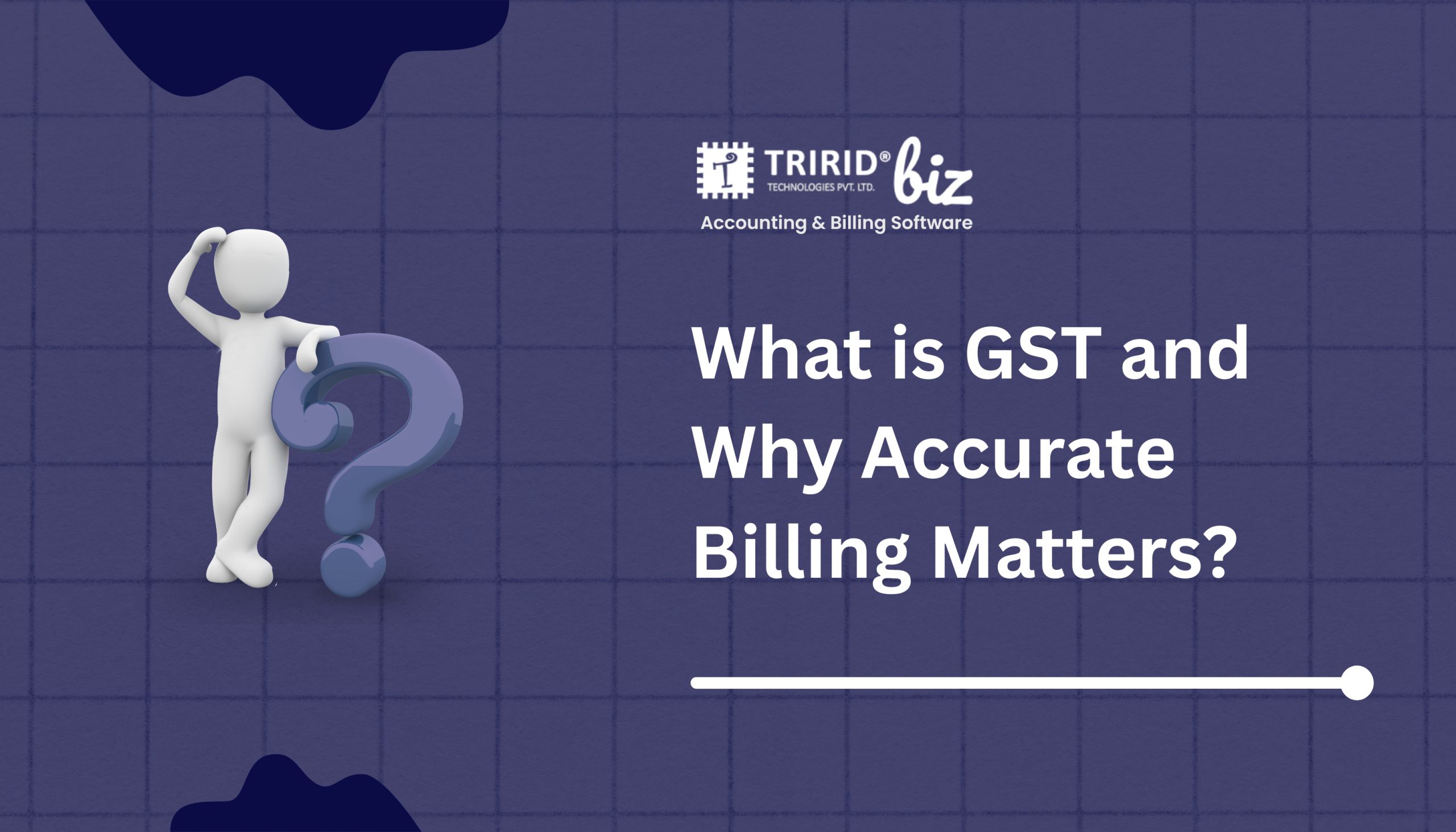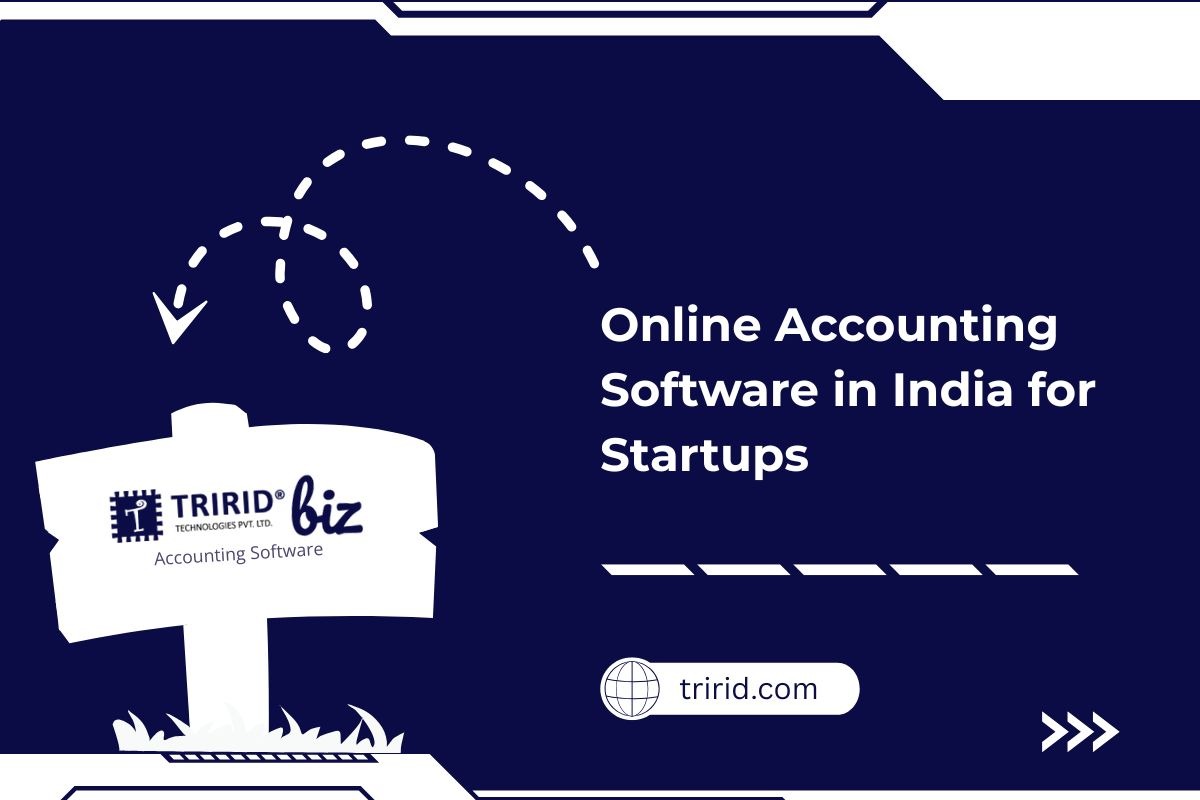What is GST and Why Accurate Billing Matters?
It’s a Goods and Services Tax (GST) that came out for India as an indirect tax system under one head to replace the various indirect taxes such as VAT, service tax, and excise duty with effect from July 01, 2017, to simplify the taxation process in the country. The main intention was to create a tax system to be called “one nation, one tax,” making compliance easy and boosting transparency in business transactions.
GST can be classified into three categories from the point of view of nature of the transaction; they include:
- CGST (Central GST): Which is levied on an intra-state sale by the central government.
- SGST (State GST): Which is levied on an intra-state sale by the state government.
- IGST (Integrated GST): Which is levied on inter-state transactions and falls under the head of central government for collection.
Having said that, India’s GST tax system has been formulated by defining multiple tax slabs such as 5%, 12%, 18%, and 28%, depending on the type of goods or services. Generally, it has been observed that essential appeals are placed in the lower slabs, while luxury ones go as high as possible.
Healthy and Accurate Billing in GST
Accurate billing plays an important part in GST compliance. A proper invoice should include:
- Invoice number and date
- Seller and buyer’s GSTIN
- HSN/SAC codes
- Tax rate and amount break up
- Place of delivery
The effects of errors in billing, such as wrong GSTINs, incorrect tax rates, or missing invoice elements, are that they lead to mismatching of returns and thus delay in input tax credits. By the GST Law, wrong billing can attract fines starting from ₹10,000 or 10% of the tax due-whichever is higher.
Benefits of Accurate GST Billing
- Germ-free Return Filing: Correct invoices assure that you can file GSTR-1, GSTR-3B, GSTR-9 with no discrepancy.
- Avoid Penalty: Avoid compliance hassle, audit, and government scrutiny.
- Better Business Reputation: More professional and transparent invoices create better trust in clients and stakeholders.
- Input Tax Credit Accuracy: Buyers can claim true ITC only if the invoices of their supplier are true and timely.
How Software Helps
Modern GST billing software automatically solves an equation, checks GST institutions, brings tax slabs up to date, and links the GST portal to perform direct uploads at the same time. With features like multi-user access, e-invoicing, and real-time reporting, it minimizes manual errors, optimizes tax compliance, and saves time.
Final Words
GST simplified taxation in India. But accurate billing is essential for compliance and competitiveness in business. Whether you run a small or large enterprise, entrusting reliable billing tools to use best practices is sufficient for smoother operational processes while keeping illegal risks at bay and developing long-term trust from customers and tax authorities.
FAQ
Penalties for Wrong GST Billing?
Penalties will start from a minimum of ₹10,000 or 10% of the tax amount and may be accompanied by an interest charge and GST registration cancellation for repeated offenders.
How frequently should GST invoicing be reconciled?
For GST billing, is the use of free tools permissible for small businesses?
A: Yes! Many included applications on their scene offer free basic GST billing features perfectly suited for startups or micro-businesses.
What are necessary features of GST billing software?
Auto-calculation, GSTIN validation, HSN/SAC codes, integration of GSTR filing, and e-invoicing.
Will e-invoicing be a requirement for all businesses?
As of now, registration for e-invoicing is required for turnover more than ₹5 crores, but it might become universal in the future.








Caiden3365
May 24, 2025Good partner program https://shorturl.fm/m8ueY
Ryder4274
May 24, 2025https://shorturl.fm/j3kEj
Violet1023
May 25, 2025https://shorturl.fm/N6nl1
Gilbert1039
May 26, 2025https://shorturl.fm/XIZGD
Karina419
May 26, 2025https://shorturl.fm/5JO3e
Marshall2711
May 26, 2025https://shorturl.fm/j3kEj
Deborah258
May 26, 2025https://shorturl.fm/oYjg5
Daisy4362
May 27, 2025https://shorturl.fm/YvSxU
Noelle2950
May 27, 2025https://shorturl.fm/6539m
Donald3606
May 27, 2025https://shorturl.fm/N6nl1
Carter3999
May 27, 2025https://shorturl.fm/XIZGD
Katelyn1971
May 27, 2025https://shorturl.fm/YvSxU
Angie3085
May 27, 2025https://shorturl.fm/FIJkD
Amber4641
May 29, 2025https://shorturl.fm/oYjg5
Jean1433
May 29, 2025https://shorturl.fm/5JO3e
Mona2206
May 30, 2025https://shorturl.fm/ypgnt
Natalie3747
May 31, 2025https://shorturl.fm/I3T8M
Samuel4187
May 31, 2025https://shorturl.fm/0oNbA
Gina2017
June 1, 2025https://shorturl.fm/0oNbA
Joe2553
June 1, 2025https://shorturl.fm/fSv4z
Percy424
June 1, 2025https://shorturl.fm/YZRz9
Grace568
June 1, 2025https://shorturl.fm/0EtO1
Effie3280
June 2, 2025https://shorturl.fm/0EtO1
Hailee3042
June 2, 2025https://shorturl.fm/nqe5E
Norma1697
June 2, 2025https://shorturl.fm/YZRz9
Duaneploda
June 17, 2025Данный портал собирает важные инфосообщения в одном месте.
Здесь доступны факты и мнения, науке и других областях.
Материалы выходят регулярно, что позволяет следить за происходящим.
Понятная навигация делает использование комфортным.
https://ekbtoday.ru
Все публикации оформлены качественно.
Редакция придерживается достоверности.
Присоединяйтесь к читателям, чтобы быть в центре внимания.
установка средств видеонаблюдения
June 20, 2025Монтаж систем видеонаблюдения поможет контроль территории круглосуточно.
Продвинутые системы обеспечивают четкую картинку даже при слабом освещении.
Наша компания предоставляет широкий выбор систем, адаптированных для бизнеса и частных объектов.
установка видеонаблюдения в частном доме своими руками
Грамотная настройка и сервисное обслуживание делают процесс эффективным и комфортным для любых задач.
Свяжитесь с нами, для получения персональную консультацию в сфере безопасности.
Pedroplath
June 27, 2025Наш сервис поможет получить данные по заданному профилю.
Достаточно ввести никнейм в соцсетях, чтобы получить сведения .
Бот сканирует публичные данные и цифровые следы.
телеграм бот глаз бога проверка
Информация обновляется в реальном времени с фильтрацией мусора.
Идеально подходит для проверки партнёров перед важными решениями.
Анонимность и точность данных — наш приоритет .
Josephdex
July 2, 2025Ответственная игра — это комплекс мер , направленный на предотвращение рисков, включая ограничение доступа несовершеннолетним .
Сервисы должны внедрять инструменты контроля, такие как временные блокировки, чтобы минимизировать зависимость .
Регулярная подготовка персонала помогает реагировать на сигналы тревоги, например, частые крупные ставки.
https://sacramentolife.ru
Для игроков доступны горячие линии , где можно получить помощь при проявлениях зависимости.
Следование нормам включает проверку возрастных данных для обеспечения прозрачности.
Ключевая цель — создать условия для ответственного досуга, где риск минимален с психологическим состоянием.
Josephdex
July 3, 2025Ответственная игра — это комплекс мер , направленный на защиту участников , включая поддержку уязвимых групп.
Сервисы должны внедрять инструменты саморегуляции , такие как лимиты на депозиты , чтобы минимизировать зависимость .
Обучение сотрудников помогает реагировать на сигналы тревоги, например, неожиданные изменения поведения .
https://sacramentolife.ru
Для игроков доступны горячие линии , где обратиться за поддержкой при проблемах с контролем .
Соблюдение стандартов включает проверку возрастных данных для предотвращения мошенничества .
Задача индустрии создать условия для ответственного досуга, где удовольствие сочетается с вредом для финансов .
казино играть
July 4, 2025Ответственная игра — это снижение негативных последствий для участников, включая установление лимитов .
Рекомендуется устанавливать финансовые границы, чтобы не превышать допустимые расходы .
Используйте инструменты временной блокировки, чтобы ограничить доступ в случае потери контроля.
Доступ к ресурсам включает консультации специалистов, где можно получить помощь при проявлениях зависимости .
Участвуйте в компании, чтобы сохранять социальный контакт , ведь семейная атмосфера делают процесс более контролируемым .
слот
Проверяйте условия платформы: лицензия оператора гарантирует защиту данных.
RichardMok
July 5, 2025При выборе компании для квартирного перевозки важно учитывать её наличие страховки и репутацию на рынке.
Проверьте отзывы клиентов или рейтинги в интернете, чтобы оценить надёжность исполнителя.
Уточните стоимость услуг, учитывая расстояние перевозки , сезонность и дополнительные опции .
https://kuplukvartiru.com.ua/forum-nerukhomosti/remont-stroytelstvo-dyzain/14765-hruzchyky-plius-usluhy-hruzchykov-v-kyeve-y-po-vsei-ukrayne#38217
Требуйте наличия гарантий сохранности имущества и уточните условия компенсации в случае повреждений.
Оцените уровень сервиса: дружелюбие сотрудников , гибкость графика .
Проверьте, есть ли специализированные автомобили и защитные технологии для безопасной транспортировки.
RichardMok
July 6, 2025Подбирая компании для квартирного перевозки важно учитывать её лицензирование и опыт работы .
Проверьте отзывы клиентов или рейтинги в интернете, чтобы оценить профессионализм исполнителя.
Сравните цены , учитывая объём вещей, сезонность и дополнительные опции .
https://kuplukvartiru.com.ua/forum-nerukhomosti/remont-stroytelstvo-dyzain/14764-move-team-usluhy-hruzchykov-v-kyeve-y-po-vsei-ukrayne#38215
Требуйте наличия страхового полиса и уточните условия компенсации в случае повреждений.
Оцените уровень сервиса: оперативность ответов, гибкость графика .
Узнайте, используются ли специализированные грузчики и защитные технологии для безопасной транспортировки.
Jamie1190
July 8, 2025Monetize your audience with our high-converting offers—apply today! https://shorturl.fm/zPazR
Ariana2377
July 9, 2025Join our affiliate community and earn more—register now! https://shorturl.fm/dNXnk
Eliza2374
July 9, 2025Start earning passive income—become our affiliate partner! https://shorturl.fm/sB7AJ
Ayla3461
July 9, 2025Share our products, earn up to 40% per sale—apply today! https://shorturl.fm/YkK8W
Carmen1809
July 9, 2025Earn up to 40% commission per sale—join our affiliate program now! https://shorturl.fm/xJSpJ
Braxton3899
July 10, 2025Sign up and turn your connections into cash—join our affiliate program! https://shorturl.fm/55p9i
Jaden3823
July 10, 2025Apply now and receive dedicated support for affiliates! https://shorturl.fm/I8Fbh
EugeneCok
July 10, 2025Дом Patek Philippe — это pinnacle механического мастерства, где сочетаются прецизионность и эстетика .
Основанная в 1839 году компания славится ручной сборкой каждого изделия, требующей многолетнего опыта.
Изобретения, включая автоматические калибры, сделали бренд как новатора в индустрии.
Часы Patek Philippe цены
Коллекции Grand Complications демонстрируют сложные калибры и ручную гравировку , подчеркивая статус .
Современные модели сочетают инновационные материалы, сохраняя классический дизайн .
Patek Philippe — символ вечной ценности , передающий инженерную элегантность из поколения в поколение.
Gabriela2294
July 10, 2025Share our products, reap the rewards—apply to our affiliate program! https://shorturl.fm/B1vYN
Alexis409
July 10, 2025Start profiting from your network—sign up today! https://shorturl.fm/xKH8S
Anton4968
July 11, 2025Start earning passive income—join our affiliate network today! https://shorturl.fm/9L970
Shane4091
July 11, 2025Refer and earn up to 50% commission—join now! https://shorturl.fm/yPoQZ
Natasha481
July 11, 2025Refer and earn up to 50% commission—join now! https://shorturl.fm/yPoQZ
Trent4178
July 11, 2025Monetize your audience with our high-converting offers—apply today! https://shorturl.fm/hkbtS
JaimeTok
July 11, 2025Доставка грузов из Китая в Россию проводится через железнодорожные маршруты , с таможенным оформлением на в портах назначения.
Таможенные пошлины составляют от 5% до 30% , в зависимости от категории товаров — например, сельхозпродукты облагаются по максимальной ставке.
Для ускорения процесса используют серые каналы доставки , которые быстрее стандартных методов , но связаны с дополнительными затратами.
Доставка грузов из Китая
При официальном оформлении требуется предоставить паспорта на товар и декларации , особенно для сложных грузов .
Время транспортировки варьируются от нескольких дней до двух недель , в зависимости от удалённости пункта назначения и загруженности контрольных пунктов.
Стоимость услуг включает транспортные расходы, таможенные платежи и услуги экспедитора, что влияет на рентабельность поставок.
JerryWed
July 11, 2025I used to think following instructions was enough. The system moves you along — you don’t question the process. It felt clean. But that illusion broke slowly.
First came the fatigue. I told myself “this is normal”. Still, my body kept rejecting the idea. I watched people talk about their own experiences. The warnings were there — just buried in jargon.
kamagra 100 mg oral jelly
I started seeing: your body isn’t a template. The same treatment can heal one and harm another. Damage accumulates. Still we don’t ask why.
Now I question more. But because no one knows my body better than I do. I take health personally now. Not all doctors love that. This is self-respect, not defiance. The lesson that stuck most, it would be keyword.
Duaneploda
July 12, 2025Эта платформа собирает актуальные новости со всего мира.
Здесь можно найти аналитика, бизнесе и многом другом.
Материалы выходят почти без перерывов, что позволяет следить за происходящим.
Минималистичный дизайн облегчает восприятие.
https://megakazan.ru
Каждое сообщение предлагаются с фактчеком.
Целью сайта является объективности.
Присоединяйтесь к читателям, чтобы быть всегда информированными.
Kevin3743
July 12, 2025Start sharing our link and start earning today! https://shorturl.fm/hBQVr
Brody3099
July 12, 2025Share your unique link and cash in—join now! https://shorturl.fm/P3BQS
Clint4273
July 13, 2025Boost your earnings effortlessly—become our affiliate! https://shorturl.fm/4ydK6
Ginger2621
July 13, 2025Start earning on every sale—become our affiliate partner today! https://shorturl.fm/Gv70g
KevinDuank
July 13, 2025Хотите найти информацию о человеке ? Этот бот предоставит полный профиль в режиме реального времени .
Используйте продвинутые инструменты для анализа публичных записей в соцсетях .
Узнайте контактные данные или интересы через систему мониторинга с верификацией результатов.
глаз бога по номеру
Система функционирует с соблюдением GDPR, обрабатывая общедоступную информацию.
Получите детализированную выжимку с историей аккаунтов и графиками активности .
Доверьтесь надежному помощнику для исследований — точность гарантирована!
Anaya2410
July 13, 2025Join our affiliate community and start earning instantly! https://shorturl.fm/mdgUe
Charlie4618
July 14, 2025Earn passive income with every click—sign up today! https://shorturl.fm/hwD04
Duaneploda
July 14, 2025Этот сайт размещает важные инфосообщения разных сфер.
Здесь доступны факты и мнения, науке и разных направлениях.
Материалы выходят в режиме реального времени, что позволяет следить за происходящим.
Понятная навигация помогает быстро ориентироваться.
https://hypebeasts.ru
Каждое сообщение написаны грамотно.
Мы стремимся к информативности.
Оставайтесь с нами, чтобы быть в центре внимания.
rolex-submariner-shop.ru
July 14, 2025Rolex Submariner, выпущенная в 1954 году стала первыми водонепроницаемыми часами , выдерживающими глубину до 100 метров .
Модель имеет 60-минутную шкалу, Triplock-заводную головку, обеспечивающие безопасность даже в экстремальных условиях.
Конструкция включает светящиеся маркеры, стальной корпус Oystersteel, подчеркивающие спортивный стиль.
Хронометры Ролекс Субмаринер цены
Механизм с запасом хода до 3 суток сочетается с автоматическим калибром , что делает их надежным спутником для активного образа жизни.
С момента запуска Submariner стал эталоном дайверских часов , оцениваемым как эксперты.
Steven1048
July 14, 2025Monetize your traffic with our affiliate program—sign up now! https://shorturl.fm/baSst
Elizabeth302
July 15, 2025Start earning passive income—become our affiliate partner! https://shorturl.fm/bimTo
Destiny2995
July 15, 2025Drive sales, collect commissions—join our affiliate team! https://shorturl.fm/kxC87
Colt4126
July 15, 2025Get paid for every referral—enroll in our affiliate program! https://shorturl.fm/euS4D
Clifton4515
July 15, 2025Start earning passive income—become our affiliate partner! https://shorturl.fm/AS1HG
Angel4502
July 16, 2025Turn your traffic into cash—join our affiliate program! https://shorturl.fm/251ZY
Steve985
July 16, 2025Unlock exclusive rewards with every referral—enroll now! https://shorturl.fm/oAg52
Wilson582
July 16, 2025Turn referrals into revenue—sign up for our affiliate program today! https://shorturl.fm/p3hSQ
Billy1151
July 16, 2025Sign up for our affiliate program and watch your earnings grow! https://shorturl.fm/E5O8U
Mateo4630
July 17, 2025Tap into a new revenue stream—become an affiliate partner! https://shorturl.fm/DbfcO
Chad3867
July 17, 2025Boost your profits with our affiliate program—apply today! https://shorturl.fm/dejgk
Lance3773
July 17, 2025Earn passive income on autopilot—become our affiliate! https://shorturl.fm/O7by8
Harlandaync
July 18, 2025La montre connectée Garmin fēnix® Chronos représente un summum de luxe avec des matériaux premium comme le titane Grade-5 et capteurs multisports.
Adaptée aux activités variées, elle propose une polyvalence et autonomie prolongée , idéale pour les aventures en extérieur grâce à ses outils de navigation .
Grâce à son autonomie allant jusqu’à 6 heures , cette montre s’impose comme une solution fiable , même lors de sessions prolongées .
https://www.garmin-boutique.com/forerunner/forerunner-245-music-noire.aspx
Les fonctions de santé incluent la fréquence cardiaque en temps réel , accompagnées de conseils d’entraînement personnalisés, pour les amateurs de fitness .
Intuitive à utiliser, elle s’intègre à votre quotidien , avec un écran AMOLED lumineux et compatibilité avec les apps mobiles .
Carly1757
July 18, 2025Start earning passive income—join our affiliate network today! https://shorturl.fm/4luJQ
Camila1499
July 18, 2025Share your link, earn rewards—sign up for our affiliate program! https://shorturl.fm/Pwqjy
Ricky3963
July 18, 2025Earn big by sharing our offers—become an affiliate today! https://shorturl.fm/B2zLU
Alaina3568
July 18, 2025Boost your income effortlessly—join our affiliate network now! https://shorturl.fm/eTjds
Harlandaync
July 18, 2025La montre connectée Garmin fēnix® Chronos est un modèle haut de gamme avec un design élégant et fonctionnalités GPS intégrées .
Adaptée aux activités variées, elle allie robustesse et autonomie prolongée , idéale pour les aventures en extérieur grâce à ses modes sportifs.
Grâce à son autonomie allant jusqu’à 6 heures , cette montre s’impose comme une solution fiable , même lors de sessions prolongées .
garmin fenix 5
Les outils de suivi incluent le comptage des calories brûlées, accompagnées de notifications intelligentes , pour les utilisateurs exigeants.
Facile à personnaliser , elle s’adapte à vos objectifs, avec une interface tactile réactive et synchronisation sans fil.
Hayden4807
July 19, 2025Start profiting from your network—sign up today! https://shorturl.fm/GbD42
Eduardo2549
July 19, 2025Join our affiliate community and start earning instantly! https://shorturl.fm/DMQZ6
Axel1823
July 19, 2025Boost your income effortlessly—join our affiliate network now! https://shorturl.fm/qiY64
Jeannette4138
July 19, 2025Grow your income stream—apply to our affiliate program today! https://shorturl.fm/roWq8
Anaya1302
July 19, 2025Maximize your income with our high-converting offers—join as an affiliate! https://shorturl.fm/pNrQA
Zachary1666
July 19, 2025Share our offers and watch your wallet grow—become an affiliate! https://shorturl.fm/96err
Cliff646
July 20, 2025Share our products and watch your earnings grow—join our affiliate program! https://shorturl.fm/uFs3I
DavidDrifs
July 20, 2025This platform aggregates latest headlines on designer collections and emerging styles, sourced from权威 platforms like Vogue and WWD.
From Gen Z’s bold maximalism to sustainable fabrics, discover insights aligned with fashion week calendars and trade show highlights.
Follow updates on brands like Pronounce and analyses of celebrity style featured in Vogue Business.
Learn about design philosophies through features from Inside Fashion Design and Who What Wear UK ’s trend breakdowns.
Whether you seek streetwear trends or shopping recommendations, this site curates content for professionals alike.
https://london.luxepodium.com/
Duaneploda
July 20, 2025Наш ресурс предлагает свежие новости со всего мира.
Здесь можно найти события из жизни, бизнесе и разных направлениях.
Контент пополняется регулярно, что позволяет держать руку на пульсе.
Понятная навигация помогает быстро ориентироваться.
https://nash-mihailovsk.ru
Каждая статья оформлены качественно.
Мы стремимся к честной подачи.
Оставайтесь с нами, чтобы быть в курсе самых главных событий.
Francesco4114
July 21, 2025https://shorturl.fm/PbV1z
Deborah1412
July 21, 2025https://shorturl.fm/FlOp8
Chandler2388
July 21, 2025https://shorturl.fm/UP2rx
Teagan4364
July 21, 2025https://shorturl.fm/beCzE
Austin4341
July 21, 2025https://shorturl.fm/CoCqi
Aline3894
July 22, 2025https://shorturl.fm/4ncaR
Anne1656
July 22, 2025https://shorturl.fm/opkse
Lucy2152
July 23, 2025https://shorturl.fm/PxEtR
JosephCah
July 23, 2025Zodpovědný hazard znamená kontrolu nad vlastními návyky , aby se minimalizovalo riziko závislosti a zároveň se uchovala zábavní hodnota.
Platformy umožňují nastavit denní týdenní nebo měsíční limity , což pomáhá hráčům udržet časovou míru.
Každý hráč by měl znát svá práva , jako jsou pokusy o návrat prohraných prostředků.
mostbet legal
Online kasina jsou povinna ověřovat věk uživatelů , aby chránila mladistvé před nežádoucím vlivem.
V případě potřeby lze využít bezplatných poradenských služeb, které pomáhají při návratu k vyváženému životnímu stylu .
Shane2763
July 23, 2025https://shorturl.fm/8YIFO
Georgia1107
July 23, 2025https://shorturl.fm/xzWMG
Collin3424
July 24, 2025https://shorturl.fm/v41NR
Allen756
July 24, 2025https://shorturl.fm/TGHZs
Mike2923
July 24, 2025https://shorturl.fm/BetfB
Colin2574
July 24, 2025https://shorturl.fm/2EAjd
Teresa694
July 25, 2025https://shorturl.fm/rZous
Imelda3327
July 25, 2025https://shorturl.fm/P8Yiq
Larry438
July 25, 2025https://shorturl.fm/3wmGf
Noah1936
July 25, 2025https://shorturl.fm/88REK
Aurora2110
July 25, 2025https://shorturl.fm/5UTcB
Lorenzo2735
July 25, 2025https://shorturl.fm/XUP3b
Cameron998
July 25, 2025https://shorturl.fm/5SeNL
Savannah2903
July 25, 2025https://shorturl.fm/3KQua
Clark1872
July 26, 2025https://shorturl.fm/sHL4n
Darwin1210
July 26, 2025https://shorturl.fm/Jnqsx
Rex1534
July 26, 2025https://shorturl.fm/IOVYh
DavidMot
July 26, 2025Программы для учёта рабочего времени помогают компаниям , оптимизируя ведение рабочего времени сотрудников .
Инновационные инструменты предоставляют точный мониторинг в режиме реального времени , минимизируя ошибки при подсчёте.
Совместимость с кадровыми системами упрощает формирование отчётов а также контроль графиками, отпусками .
программы контроля задач
Упрощение задач сокращает затраты HR-отделов, позволяя сосредоточиться на стратегических целях .
Простое управление гарантирует удобство использования даже для новичков , сокращая период обучения .
Защищённые системы генерируют детальную аналитику , способствуя принятию обоснованных решений .
Diane4135
July 27, 2025https://shorturl.fm/55Eh6
Dale1465
July 27, 2025https://shorturl.fm/vJQa8
Andrew4997
July 27, 2025https://shorturl.fm/WtOGJ
Mario456
July 28, 2025https://shorturl.fm/WQg12
Hailee984
July 28, 2025https://shorturl.fm/uC2UP
Carrie2848
July 28, 2025https://shorturl.fm/o53P0
Mason3677
July 28, 2025https://shorturl.fm/gT0gw
Conner2418
July 29, 2025https://shorturl.fm/twpAr
Preston3451
July 29, 2025https://shorturl.fm/Mj63n
Audrey4934
July 29, 2025https://shorturl.fm/nWHCx
Brendan3160
July 29, 2025https://shorturl.fm/Rdi4n
Bill2958
July 29, 2025https://shorturl.fm/Oi67f
Isaiah4931
July 29, 2025https://shorturl.fm/bN40P
Daisy4282
July 30, 2025https://shorturl.fm/o0CJU
Joe1407
July 31, 2025https://shorturl.fm/gPhEr
Marina98
July 31, 2025https://shorturl.fm/BOk9b
Courtney4832
July 31, 2025https://shorturl.fm/vHrRo
Jermaine1199
July 31, 2025https://shorturl.fm/TiOk5
Jonathan4138
July 31, 2025https://shorturl.fm/23SSz
WalterBip
July 31, 2025Татуировка представляет собой уникальное искусство , где каждый элемент несёт глубокий смысл и отражает характер человека.
Для многих тату — душевный акцент, который напоминает о важных моментах и дополняет жизненный опыт.
Сам акт нанесения — это ритуал доверия между мастером и человеком, где кожа превращается полотном эмоций.
средства ухода за татуировкой
Разные направления, от акварельных рисунков до традиционных орнаментов , позволяют воплотить самую смелую фантазию в изысканной форме .
Красота тату в способности расти вместе с хозяином , превращая эмоции в незабываемый визуальный язык .
Выбирая узор , люди показывают своё «я» через цвета , создавая личное произведение, которое радует глаз каждый день.
Robertloork
July 31, 2025Татуировка представляет собой уникальное искусство , где каждая линия несёт глубокий смысл и отражает характер человека.
Для сотен людей тату — душевный акцент, который вдохновляет о преодолённых трудностях и дополняет жизненный опыт.
Сам акт нанесения — это ритуал доверия между мастером и клиентом , где тело становится полотном эмоций.
средства ухода за татуировкой
Современные стили , от акварельных рисунков до традиционных орнаментов , помогают передать любую идею в гармоничном исполнении.
Эстетика нательного искусства в их вечности вместе с человеком, превращая эмоции в незабываемый визуальный язык .
Выбирая узор , люди раскрывают душу через формы, создавая неповторимый шедевр , которое радует глаз каждый день.
Hailee461
August 1, 2025https://shorturl.fm/bDNow
Lori499
August 1, 2025https://shorturl.fm/Ge56k
Isaiah67
August 1, 2025https://shorturl.fm/PeLdK
Kingston1202
August 2, 2025https://shorturl.fm/bTN1G
Channing1382
August 2, 2025https://shorturl.fm/xVHeN
Lachlan3838
August 2, 2025https://shorturl.fm/fTZvk
Lucas1646
August 3, 2025https://shorturl.fm/sZsAl
Francesco952
August 4, 2025https://shorturl.fm/ARwXG
Chloe4415
August 4, 2025https://shorturl.fm/Hu66W
Richardoweno
August 4, 2025The Rolex Cosmograph Daytona Rainbow showcases high-end craftsmanship with its colorful ceramic chapter ring.
Made from precious metals , it combines racing-inspired mechanics with sophisticated design elements.
Produced as exclusive editions , this timepiece appeals to luxury enthusiasts worldwide.
Rolex Daytona Rainbow reviews
Every gradient stone on the outer ring forms a vibrant arc that catches the light .
Powered by Rolex’s self-winding chronograph movement , it ensures exceptional accuracy for daily wear .
A symbol of status , the Daytona Rainbow celebrates timeless desirability in the finest craftsmanship.
Helen410
August 11, 2025https://shorturl.fm/7xXgp
Anderson3261
August 11, 2025https://shorturl.fm/lRH62
Brennan3865
August 11, 2025https://shorturl.fm/0GV78
Thomasbruic
August 11, 2025Les devices connectées offrent des technologies performantes au quotidien.
Équipées de écran AMOLED ainsi que de suivi du sommeil , elles s’adaptent à chaque niveaux.
L’autonomie peut aller jusqu’à jusqu’à 14 jours selon le modèle, parfaite pour usage quotidien.
Garmin Forerunner
Les fonctions santé analysent les étapes et aussi le stress , aidant à optimal.
Simples en utiliser , ces montres se synchronisent sans effort avec vos apps , grâce à un design intuitive .
Choisir Garmin garantit profiter de une technologie éprouvée pour améliorer votre quotidien.
Katelyn4086
August 12, 2025https://shorturl.fm/d61Mv
Martin282
August 12, 2025https://shorturl.fm/YXvkV
ErnestBlalm
August 14, 2025Bilinçli kumar oynamak , riskleri azaltır.
Oyun bütçenizi önceden belirlemek , kontrolü tutmaya katkı sağlar .
Kendinizi sınırlandırma araçlarını kullanmak, sorunları engellemenize yardımcı olur .
Alevtr Casino
Bahislerin etkilerinin farkında olmak, dengeli katılım temin eder .
İhtiyaç halinde yardım grubu aramak, sorunları artırmaya yardımcı olur.
Bu önlemler, sorunsuz keyifli casino katılımı keyfini maksimize eder.
DoyleAlada
August 17, 2025https://t.me/s/onewin_kanal/10410
Jason3800
August 24, 2025https://shorturl.fm/nfFQi
Kevinoxype
August 25, 2025Продвинутые инструменты учёта рабочего времени способствуют улучшению эффективности .
Автоматизация процессов минимизирует ошибки в отчётности .
Руководителям удобнее анализировать загрузку сотрудников с детализацией.
https://administratiepakket.info/finance/video-monitoring-vs-software-for-tracking/
Работники имеют удобный учёт к своим данным .
Переход на автоматизацию существенно упрощает внутренние операции с минимальными усилиями .
Это гарантирует доверие при распределении задач, сохраняя лояльность персонала .